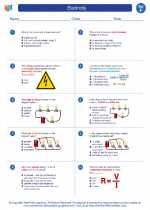Golgi Apparatus
The Golgi Apparatus, also known as the Golgi complex, is a cell organelle found in eukaryotic cells. It plays a crucial role in processing, packaging, and distributing proteins and lipids within the cell. The Golgi Apparatus is named after the Italian physician Camillo Golgi who first identified it in 1898.
Structure
The Golgi Apparatus is composed of a series of flattened, membrane-bound sacs called cisternae. These cisternae are stacked on top of each other, resembling a stack of pancakes. The Golgi Apparatus also has vesicles that transport molecules to and from the endoplasmic reticulum and other parts of the cell.
Function
The main functions of the Golgi Apparatus include:
- Protein Modification: The Golgi modifies proteins by adding sugar molecules or phosphate groups to them, which is essential for their proper functioning.
- Protein Sorting: It sorts and packages proteins into vesicles for transport to their final destination within or outside the cell.
- Lipid Processing: The Golgi also processes and modifies lipids, which are essential components of cell membranes.
- Secretion: It is involved in the secretion of substances from the cell by packaging them into vesicles that fuse with the cell membrane and release their contents outside the cell.
Study Guide
Here are some key points to remember when studying the Golgi Apparatus:
- Describe the structure of the Golgi Apparatus and explain its role in the processing and packaging of molecules.
- Understand the process of protein modification and sorting that occurs in the Golgi Apparatus.
- Explain the importance of the Golgi Apparatus in the secretion of substances from the cell.
- Compare and contrast the Golgi Apparatus with other cell organelles, such as the endoplasmic reticulum and lysosomes.
- Discuss the impact of any malfunctions or abnormalities in the Golgi Apparatus on cellular function and overall health.
◂Science Worksheets and Study Guides Sixth Grade. Electricity
Study Guide Electricity
Electricity  Activity Lesson
Activity Lesson Electricity
Electricity  Worksheet/Answer key
Worksheet/Answer key Electricity
Electricity  Worksheet/Answer key
Worksheet/Answer key Electricity
Electricity  Worksheet/Answer key
Worksheet/Answer key Electricity
Electricity  Worksheet/Answer key
Worksheet/Answer key Electricity
Electricity  Vocabulary/Answer key
Vocabulary/Answer key Electricity
Electricity  Vocabulary/Answer key
Vocabulary/Answer key Electricity
Electricity 

 Activity Lesson
Activity Lesson
 Worksheet/Answer key
Worksheet/Answer key
 Worksheet/Answer key
Worksheet/Answer key
 Worksheet/Answer key
Worksheet/Answer key
 Worksheet/Answer key
Worksheet/Answer key
 Vocabulary/Answer key
Vocabulary/Answer key
 Vocabulary/Answer key
Vocabulary/Answer key

The resources above cover the following skills:
PHYSICAL SCIENCE
Motion and Stability: Forces and Interactions
Students who demonstrate understanding can:
Ask questions about data to determine the factors that affect the strength of electric and magnetic forces.